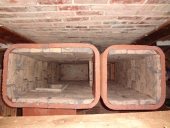
















Success has a Thousand Fathers , Failure is an Orphan
LOOK AT THE " SIMILAR THREADS " BELOW !




James Fleming wrote:I am curious as to why the barrel is not wrapped in thermal mass (i.e. 3-6" of cob) although that would slow the initial radient heating of the room, wouldn't that provide a longer, more even heating of the room?
 1
1

















James Fleming wrote:Thanks all - it seems that the fact the bare metal loses heat more rapidly is the magic of it all. How hot does the outside of the drum get? Should one put a guard or screen of some type to prevent someone from touching it accidentally?










Success has a Thousand Fathers , Failure is an Orphan
LOOK AT THE " SIMILAR THREADS " BELOW !





John Elliott wrote:
James Fleming wrote:Thanks all - it seems that the fact the bare metal loses heat more rapidly is the magic of it all. How hot does the outside of the drum get? Should one put a guard or screen of some type to prevent someone from touching it accidentally?
My two inches of cob can get up to 140F when the RMH is roaring full blast, so consider that a lower bound. Metal is going to be quite a bit hotter, enough to give a nasty burn if touched accidentally.

God of procrastination https://www.youtube.com/watch?v=q1EoT9sedqY






|
I just had the craziest dream. This tiny ad was in it.
The new purple deck of permaculture playing cards
https://www.kickstarter.com/projects/paulwheaton/garden-cards
|





